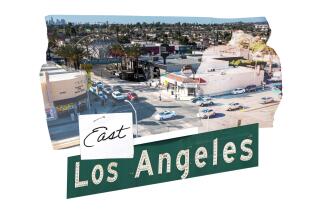Castaic Pinpointed in Drive for Santa Clarita Valley Cityhood
- Share via
Tiny, quiet Castaic was invaded Saturday by a dozen leaflet-toting proponents of cityhood for the Santa Clarita Valley.
The quiet community of about 1,000 households, which lies along the Golden State Freeway near Lake Hughes, is at the center of a struggle for the creation of the city of Santa Clarita.
The committee pushing for cityhood had included Castaic within the proposed boundaries of the city, along with Canyon Country, Saugus, Newhall and Valencia. But earlier this month, the Los Angeles County Local Agency Formation Committee, which assesses the economic viability of proposed cities, concluded that Castaic should be left out.
According to Carl Boyer III, chairman of the City of Santa Clarita Formation Committee, Castaic is an integral part of the valley and more than half the registered voters in Castaic have signed a petition saying they want a chance to vote on the proposed cityhood.
But, Boyer said Saturday, that is not enough. A series of public hearings will be held by LAFCO later this month, and the cityhood committee wants Castaic residents lined up on its side, he said.
Urged to Express Views
The committee printed 1,000 leaflets, each with an attached stamped postcard addressed to LAFCO Executive Director Ruth Benell. Castaic residents were urged in the leaflet to speak their mind, whatever their opinion.
The volunteers, from all corners of the Santa Clarita Valley, assembled in the parking lot of Castaic Landing Restaurant, a busy truck stop between the Golden State Freeway and the dam that holds back Castaic Lake. Each sported a small yellow button with an optimistic logo that read, in part, “City of Santa Clarita, 1987.”
Wanted Local Control The strategy was laid out by Michael Kotch, an engineer who said he moved to Castaic for the peace and quiet and wants to see local control of the fast-spreading development that is reaching into the canyons and up the brushy slopes. Kotch passed out maps, flyers and rubber bands.
Off the volunteers went in pairs, toting armfuls of leaflets and pocketfuls of rubber bands--used to attach the rolled leaflets to doorknobs. Each pair was assigned a zone--a housing development, a mobile home park, a cluster of equestrian properties, a condominium.
Kotch helped canvass an area known as Old Castaic, a tract of aging ranch houses with several dogs and horses in nearly every yard.
Mixture of Opinions
Walking up unpaved Ferguson Road, he encountered a mixture of opinions.
One resident stumped Kotch with a sticky question: “My property goes into the middle of this street. So does my neighbor’s across the way. . . . That’s why it isn’t paved. Is the city going to take my property?”
Kotch said the only real change with cityhood would be that local problems such as this one would be resolved locally--by a city council--instead of downtown by county supervisors.
Just down the road, three residents, leaning against a fence as they watched a truck pump out a septic tank, tended to support cityhood but were wary about the consequences.
Lisa and Stan Hernacki, whose tank was being pumped, said they like the idea of street lights--and especially sewers--but are not eager to lose the “country-style” feel of the neighborhood.
“People still ride their horses up this street in the evenings,” Stan Hernacki said.
More to Read
Sign up for Essential California
The most important California stories and recommendations in your inbox every morning.
You may occasionally receive promotional content from the Los Angeles Times.










